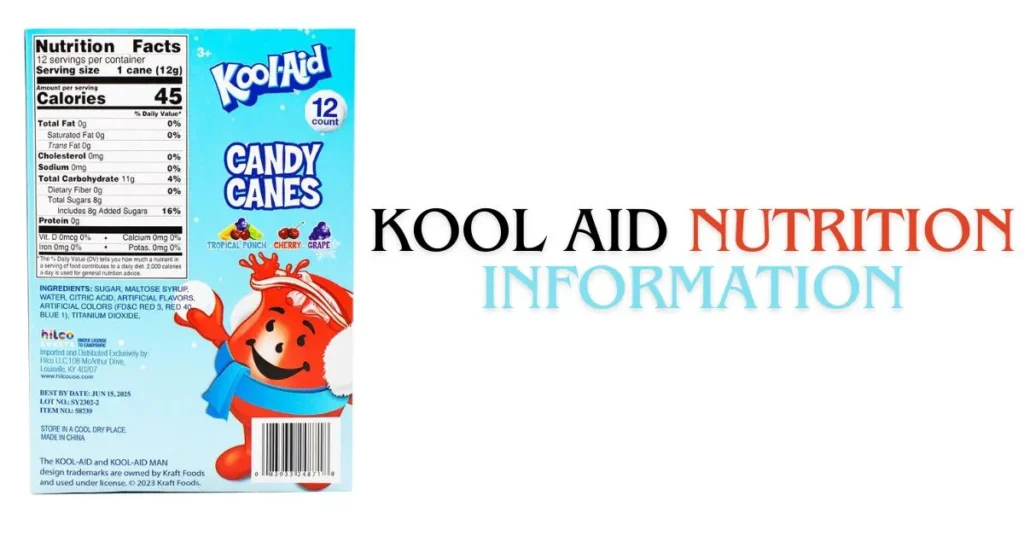When you think of childhood refreshments, Kool-Aid is likely one of the first things that come to mind. Those vibrant packets of flavored powder mixed with sugar and water have been a staple at family gatherings, summer camps, and birthday parties for decades. But have you ever wondered about the nutritional content of Kool-Aid? Let’s dive into everything you need to know about Kool-Aid nutrition information.
What’s in a Packet? The Ingredients
Kool-Aid’s simple ingredient list might surprise you. The primary ingredients include citric acid, calcium phosphate, salt, and artificial flavorings and colors. One thing to note is that the standard Kool-Aid powder does not contain any sugar until you add it yourself.
Citric acid acts as a preservative and adds a tangy flavor, while calcium phosphate helps prevent the mixture from clumping. The artificial flavors and colors give Kool-Aid its iconic look and taste. However, these artificial additives have raised some concerns among health-conscious consumers.
How Much Sugar Are We Talking About?
Sugar content is one of the most significant aspects of Kool-Aid nutrition information. The base Kool-Aid powder is sugar-free, but the preparation instructions typically call for adding a cup of sugar per two-quart pitcher. This amount of sugar can significantly impact the overall nutritional value.
To put it in perspective, one cup of granulated sugar contains approximately 200 grams of sugar. When you mix this with a two-quart pitcher of Kool-Aid, each 8-ounce serving will have around 25 grams of sugar. That’s about 6 teaspoons of sugar per glass! This high sugar content can be concerning, especially for those watching their sugar intake.
Calories and Carbs: Breaking It Down
With sugar being a major component, the calorie count of Kool-Aid can add up quickly. Each 8-ounce serving of Kool-Aid with sugar contains roughly 100 calories. These calories come primarily from carbohydrates, thanks to the added sugar.
For those counting carbs, this equates to around 25 grams of carbohydrates per serving. It’s important to consider this if you’re managing your carb intake for health reasons like diabetes or a low-carb diet. Opting for a sugar-free version of Kool-Aid can significantly reduce both calories and carbs, making it a more suitable option for those with dietary restrictions.
Vitamins and Minerals: Is There Any Nutritional Value?
Kool-Aid is not known for its nutritional benefits, but there are a few vitamins and minerals present in the drink. Some versions of Kool-Aid are fortified with vitamin C, which can be beneficial for immune health. A single serving of fortified Kool-Aid can provide about 10% of the daily recommended value of vitamin C.
However, other essential vitamins and minerals are largely absent from Kool-Aid. The drink is low in protein, fiber, and healthy fats, making it more of a sugary treat than a source of balanced nutrition. For those looking for more nutritionally dense beverages, homemade smoothies or fresh fruit juices might be a better option.
Kool-Aid Flavors: Do They Affect Nutrition?
Kool-Aid comes in a rainbow of flavors, from classic Cherry and Grape to more exotic options like Tropical Punch and Blue Raspberry Lemonade. While the flavor variety is fun and enticing, it does not significantly impact the nutritional content. Whether you choose Cherry or Lemon-Lime, the sugar content, calories, and lack of significant vitamins and minerals remain consistent.
However, it’s worth noting that some flavors may contain slightly different artificial colors and flavorings. For individuals with sensitivities or allergies to certain food dyes, checking the ingredient list on each flavor packet is a good idea.
Healthier Alternatives: Can Kool-Aid Fit Into a Balanced Diet?
If you love the nostalgic taste of Kool-Aid but want to enjoy it more healthily, there are a few strategies you can try. Firstly, consider reducing the amount of sugar you add. Instead of a full cup, try using half a cup or less. This will decrease the calorie and sugar content per serving.
Another option is to use sugar substitutes like stevia or erythritol. These sweeteners can provide the desired sweetness without the added calories and carbs. Additionally, you can mix Kool-Aid with sparkling water for a fizzy, refreshing drink that feels more indulgent without the extra sugar.
Reading Labels: Making Informed Choices
When it comes to understanding Kool-Aid nutrition information, reading labels is crucial. Pay attention to the serving size and the amount of sugar you add. Keep in mind that the nutritional information provided on the packet is for the powder alone and does not account for added sugar.
Comparing different brands and flavors can also be helpful. Some pre-sweetened versions of Kool-Aid may have different nutritional profiles than the unsweetened packets. Always check the label to make the best choice for your dietary needs.
The Verdict: Is Kool-Aid Right for You?
Kool-Aid can be a delightful and nostalgic treat, but it’s important to enjoy it in moderation. The high sugar content and lack of essential nutrients mean it should not be a staple in your diet. For special occasions or as an occasional indulgence, Kool-Aid can be a fun and tasty beverage.
However, for everyday hydration, consider beverages with more nutritional value. Water, herbal teas, and natural fruit juices can provide hydration and essential nutrients without the added sugar. Remember, balance is key in any diet, and making informed choices about what you drink is an important part of maintaining a healthy lifestyle.
Conclusion: Enjoying Kool-Aid Responsibly
Understanding Kool-Aid nutrition information helps you make better choices about your beverage consumption. While Kool-Aid offers a burst of flavor and nostalgia, it’s crucial to be mindful of its sugar content and lack of nutritional value. By making small adjustments, like reducing sugar or opting for sugar-free versions, you can still enjoy Kool-Aid as part of a balanced diet.
Next time you mix up a pitcher of Kool-Aid, remember these tips and enjoy your refreshing drink responsibly. Whether it’s a hot summer day or a family gathering, Kool-Aid can still have its place in your life, just with a little more awareness and moderation. Cheers to making informed choices and savoring every sip!







